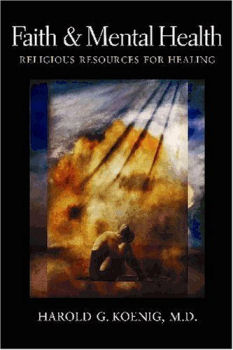
|
Posted December 18, 2005
Book: Faith and Mental Health: Religious Resources for Healing Author: Harold G. Koenig, M.D. Templeton Foundation Press, West Conshohocken, PA, 2005, pp. 343 An Excerpt from the Jacket:
An unprecedented source of practical information, Faith and Mental Health offers: - Research on the relationship between religion and positive emotions, psychiatric illnesses, and severe and persistent metal disorders. - Ways in which religion has influenced mental health historically, and how it now and in the future can be involved with mental health. - A comprehensive description and categorization of Christian and non-Christian faith-based organizations that provide mental health resources. - Resources for professionals an faith communities on how to design programs An Excerpt from the Book: Clergy Counseling Clergy deliver an enormous amount of mental health services to needy persons and families. These mental health services are seldom recognized or acknowledged by mental health professionals, who are often surprised by how much mental health care clergy actually provide. In reality, clergy are often the first line of defense for emotional problems in the population. To get a sense of the magnitude of clergy-delivered mental health services, consider the following. In 1998, according to the Department of Labor, there were approximately 353,000 clergy serving congregations in the United States. This figure includes 4,000 rabbis, 49,000 Catholic priests, and 300,000 Protestant pastors. A recent review of 10 separate studies found that clergy report spending between 10% and 20% of their 40- to 60-hour work week counseling those with emotional or marital problems. A quick calculation comes up with the following statistic. Clergy spend 138 million hours delivering mental health services each year, which amounts to the entire membership of the American Psychological Association (83,000) delivering services at the rat of 33.2 hours per week. Not included in the former figure is counseling done by chaplains or pastoral counselors, by nearly 100,000 full-time Catholic sisters, by thousands of brothers in religious orders, or by clergy from Buddhist, Hindu, Muslim, and other religious traditions in the United States. Evidence for the enormous volume of clergy-based mental health services has been around for decades, although seldom is highlighted in professional mental health circles. Twenty years ago, Veroff and colleagues examined the pattern of help seeking for personal problems in the United States between 1957 and 1976. In 1957, 43% of Americans sought help from a clergyman, 30% from a physician, 18% from a psychiatrist or psychologist, 14% from some other mental health source, and 3% from a social service agency. In 1976, 39% saw a clergyman, 21% a physician, 29% a psychiatrist or psychologist, and 24% some other mental health provider. Table of Contents: Part I: Historical Considerations 1. People and communities of faith 2. History of mental health care Part II: Research on Religion and Mental Health 3. Religion, coping, and positive emotions 4. Religion, psychiatric symptoms and disorder 5. Religion and severe, persistent mental illness 6. Integrating religion into mental health treatments Part III: Faith-Based Mental Health Care 7. Caring for the emotionally and mentally ill 8. Local religious congregations 9. Networking and advocacy organizations 10. Mission-driven faith-based services 11. Faith-integrated counseling 12. Non-Christian faith-based services 13. Barriers to research and implementation 14. Identifying possible solutions |
|
